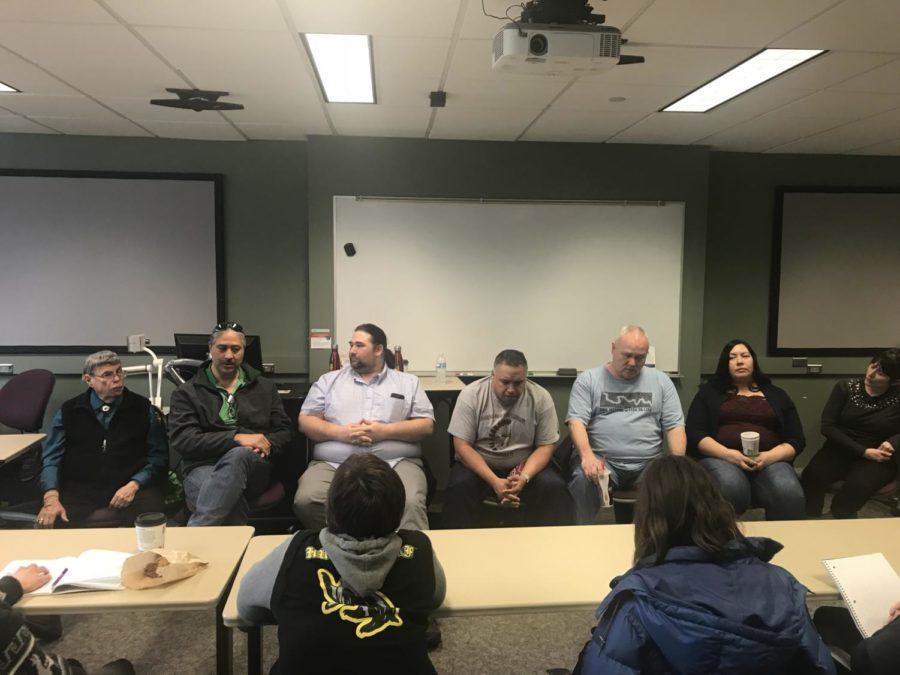Incorporating Native history in K-12 curriculum
March 27, 2018
Lagomarcino 2660 filled to capacity Tuesday afternoon and then some. As attendees packed into the room, a line started to form in the hallway. The panel was moved downstairs to the Roger P. Volker experimental technology classroom.
“We weren’t expecting this many people to show up, but it’s a good problem to have,” facilitator Katy Swalwell, associate professor in the school of education, said.
The panel’s other facilitator, Sebastian Braun, director of American Indian studies, introduced the panelists.
The panelists included David Gradwohl, professor emeritus of anthropology at Iowa State; Jason Younker, assistant vice president and advisor to the president on sovereignty and government-to-government relations at the University of Oregon; Jeffrey Burnette, director of the Native American Future Stewards Program at Rochester Institute of Technology; Richard Meyers, president of the Association of Indigenous Anthropologists, Oglala Lakota College; Lance Foster, tribal historic preservation officer, Iowa Tribe of Kansas and Nebraska; and Leah Slick-Driscoll, teacher at Meskwaki Settlement School.
“American Indians and Native Americans are still here,” Gradwohl said. “They’re very diverse in language, in kinship structure, in political systems, many things.
“They’re not always wearing beads and feathers anymore than we always are wearing Halloween masks.”
When prompted with a question asking what problematic curriculum is included in K-12 that shouldn’t be, panelists each spoke of ideas about Natives they found troubling.
Slick-Driscoll explained that many Iowans, when asked to draw an Indian, are going to draw a similar image, despite their age.
“Natives have been simplified down to the stereotypes that are presented for their propagandic purpose, and it continues to affect Natives today and the response of other Americans to Native current social issues,” Slick-Driscoll said.
The panelists agreed that a common issue Native Americans face today is being viewed as people of the past rather than the present.
“If you go and look at Google and just type in “American Indian” or “Native American” the images that you get are all people of the past, and we don’t spend much time talking about the tribal nations that are here and what that they look like right now,” Burnette said.
Younker pointed out that there are 567 sovereign domestic nations within the United States and each nation is distinguishable in their own way.
In his home state of Oregon, a law was recently passed that allows Native communities to write their own curriculum for schools.
“If that isn’t happening in every state then that’s injustice,” Younker said.
Younker went on to say that he believes it’s up to educators to bring the voice of Native people in their states to the classroom.
“But that isn’t happening,” Younker said. “It’s up to you as future educators to make sure it does. Education starts with you, and then you pass it on to your students.”
Panelists were also asked what kinds of curriculum should be included in K-12 that currently isn’t.
Slick-Driscoll said that some educators are going to end up in areas that are not very diverse and may experience anxiety teaching American history as honestly as possible. She said that history books often teach American history like a fairytale.
“I’m a history teacher, I teach history through primary documents,” Slick-Driscoll said.
Younker discussed that it’s an insult to Native culture to celebrate Indigenous Peoples’ Day on Columbus Day as Columbus was responsible for mass genocide of Native Americans.
“All you have to do is look beyond what is in the textbooks and find out what he did to people,” Younker said.
He went on to explain that tribes and reservations are finally starting to get an economic footing. In Oregon, the nine tribes’ donations to political campaigns ultimately led to the approval of letting Natives write school curriculum.
“Things are changing, but we’re starting to play the game the way it was rigged to begin with,” Younker said. “We didn’t have the money to begin with, but now we do. That’s not the case for all Native Americans.”






